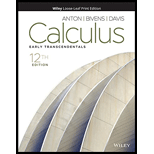
In each part, obtain the Maclaurin series for the function by making an appropriate substitution in the Maclaurin series for
Want to see the full answer?
Check out a sample textbook solution
Chapter 9 Solutions
Calculus: Early Transcendentals, Enhanced Etext
Additional Math Textbook Solutions
Intro Stats, Books a la Carte Edition (5th Edition)
Elementary Statistics (13th Edition)
Calculus: Early Transcendentals (2nd Edition)
Elementary Statistics
Pre-Algebra Student Edition
Thinking Mathematically (6th Edition)
- 4.2 Product and Quotient Rules 1. Use the product and/or quotient rule to find the derivative of each function. 2.5 a. g(x)=+1 y14+2 √x-1) b. y=(2x-3)(x-:arrow_forward3. The total profit (in dollars) from selling x watches is P(x)=0.52x²-0.0002x². Find and interpret the following. a) P(100) b) P'(100)arrow_forward3. Find the slope and the equation of the tangent line to the graph of the given function at the given value of x. -4 f(x)=x-x³;x=2arrow_forward
- 2. Find the equation of the tangent line to the graph of the given function at the given point. f(x)=(x+3)(2x²-6) at (1,-16)arrow_forward6. Researchers who have been studying the alarming rate at which the level of the Dead Sea has been dropping have shown that the density d (x) (in g per cm³) of the Dead Sea brine during evaporation can be estimated by the function d(x)=1.66 0.90x+0.47x², where x is the fraction of the remaining brine, 0≤x≤1. a) Estimate the density of the brine when 60% of the brine remains. b) Find and interpret the instantaneous rate of change of the density when 60% of the brine remains.arrow_forward5. If g'(5) 10 and h'(5)=-4, find f'(5) for f(x)=4g(x)-2h(x)+3.arrow_forward
- 2. Find each derivative. Write answers with positive exponents. a) Dx 9x -3 [97] b) f'(3) if f(x) = x²-5x² 8arrow_forwardA ladder 27 feet long leans against a wall and the foot of the ladder is sliding away at a constant rate of 3 feet/sec. Meanwhile, a firefighter is climbing up the ladder at a rate of 2 feet/sec. When the firefighter has climbed up 6 feet of the ladder, the ladder makes an angle of л/3 with the ground. Answer the two related rates questions below. (Hint: Use two carefully labeled similar right triangles.) (a) If h is the height of the firefighter above the ground, at the instant the angle of the ladder with the ground is л/3, find dh/dt= feet/sec. (b) If w is the horizontal distance from the firefighter to the wall, at the instant the angle of the ladder with the ground is л/3, find dw/dt= feet/sec.arrow_forwardTwo cars start moving from the same point. One travels south at 60 mi/h and the other travels west at 25 mi/h. At what rate (in mi/h) is the distance between the cars increasing four hours later? Step 1 Using the diagram of a right triangle given below, the relation between x, y, and z is z² = x²+ +12 x Step 2 We must find dz/dt. Differentiating both sides and simplifying gives us the following. 2z dz dt dx 2x. +2y dt dx dy dz x +y dt dt dt 2z dy dt × dx (x+y dt dy dtarrow_forward
- An elastic rope is attached to the ground at the positions shown in the picture. The rope is being pulled up along the dotted line. Assume the units are meters. 9 ground level Assume that x is increasing at a rate of 3 meters/sec. (a) Write as a function of x: 0= (b) When x=10, the angle is changing at a rate of rad/sec. (c) Let L be the the left hand piece of rope and R the right hand piece of rope. When x=10, is the rate of change of L larger than the rate of change of R? ○ Yes ○ Noarrow_forward4.1 Basic Rules of Differentiation. 1. Find the derivative of each function. Write answers with positive exponents. Label your derivatives with appropriate derivative notation. a) y=8x-5x3 4 X b) y=-50 √x+11x -5 c) p(x)=-10x²+6x3³arrow_forwardPlease refer belowarrow_forward
- Algebra & Trigonometry with Analytic GeometryAlgebraISBN:9781133382119Author:SwokowskiPublisher:Cengage
 College Algebra (MindTap Course List)AlgebraISBN:9781305652231Author:R. David Gustafson, Jeff HughesPublisher:Cengage Learning
College Algebra (MindTap Course List)AlgebraISBN:9781305652231Author:R. David Gustafson, Jeff HughesPublisher:Cengage Learning


